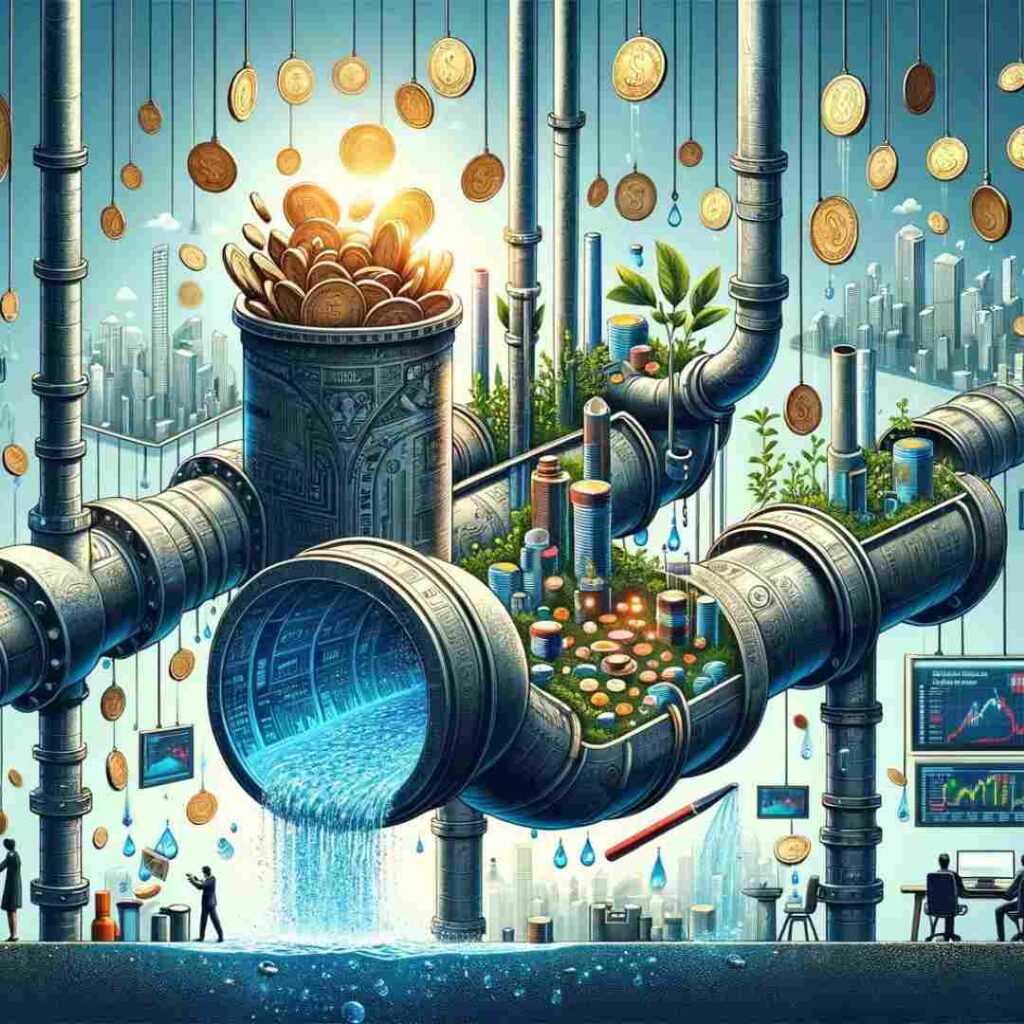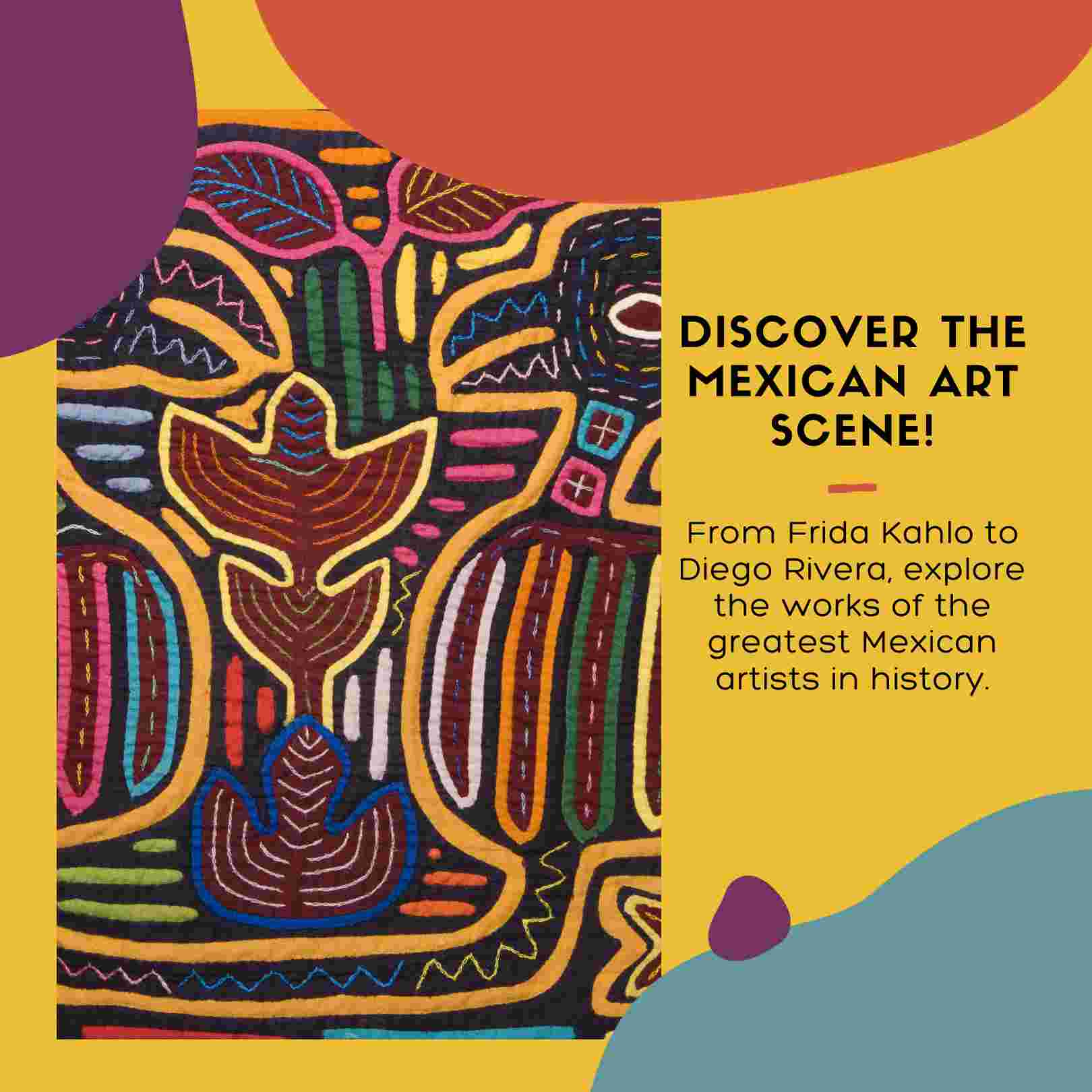
Hey there, I’m Ivan Rangel, your go-to amigo for unlocking the mysteries behind Mexican art. Picture this: art as a storyteller, weaving tales of tradition, colors and the beating heart of a whole nation. Today, we’re diving into the world of Mexican art, asking the burning question: What makes it so darn unique?
Why does it stand out in the global artistic buffet? Well, think of it like a spicy salsa bold, full of flavor and leaves an unforgettable kick. Mexican art isn’t just paint on canvas, it’s a vibe, a history lesson, a fiesta for your eyes. Ready to dig into this cultural enchilada with me?
We’re not just talking about art, we’re talking about a journey a journey through time, where each brushstroke tells a tale. So, grab your sombrero and let’s uncover the secrets of Mexican art, where every canvas is a chapter in the story of us.
Stay with me and let’s make Mexican art not just something you see but something you feel. Ready to jump into the colors and stories? Let’s roll!
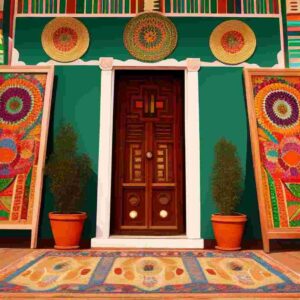
The Rich Tapestry of Mexican Art History
Ancient Roots Unearthed
Mexico’s art story kicks off way back when Instagram wasn’t a thing – in the times of the Olmec and Aztec hotshots. Imagine Netflix-worthy carvings and statues. The Olmec gang brought us those massive stone heads, each with its own mystery. Meanwhile, the Aztecs went all-in with codices, basically their version of graphic novels but cooler.
Muralism Hits the Scene
Enter Diego Rivera, the OG mural maestro. His canvas wasn’t a quaint easel, it was the walls of the National Palace in Mexico City. Think of it as Mexico’s very own Netflix series but with paint. Rivera spilled the beans on Mexican history in colors so vibrant, you’d think they had their own Wi-Fi. From ancient civilizations to the Mexican Revolution, he painted it all – the real OG storyteller.
Personal Dive into the Ancient Vibes
Now, let’s fast forward to my time-traveling escapades at places like Teotihuacan. Walking amidst ancient market vibes, I’m practically bargaining with ancient artisans. Hieroglyphs and pottery – it’s like Snapchat from centuries ago. These sites aren’t just history class field trips, they’re like opening a time capsule. The artifacts tell stories and I’m here for it.
Next up, we’re jumping from ancient vibes to today’s art scene, where tradition meets street smarts. It’s like going from black and white TV to 4K – that kind of visual upgrade. Stick around, because Mexican art isn’t just a history lesson, it’s a full-on experience and we’re just getting started. Ready for the art rollercoaster?
The Present Canvas captures Mexican Art in the Contemporary Scene
Bienvenidos to the vibrant realm of contemporary Mexican art, where tradition intertwines seamlessly with the avant-garde. In this dynamic present, artists breathe life into canvases, reflecting the diverse and evolving essence of Mexican culture.
Frida Kahlo unveils the soul through self-portraits
Think of Frida Kahlo as the OG of selfies but with way more depth. Her self-portraits aren’t just paintings, they’re raw emotion on canvas. Check out “The Two Fridas” or “Self-Portrait with Thorn Necklace and Hummingbird.” Ever wondered what’s up with that unibrow? Let’s decode the symbolism, unraveling the layers of identity and Mexican roots woven into each stroke.
Street Art Renaissance with Sego and Saner
Take a stroll through Mexican streets and you’ll find more than just tacos. Meet Sego and Saner, the poets of walls and alleys. Their murals are like love letters to Mexico, telling stories of its past and present. These guys turn concrete into canvases, making every block a piece of a living, breathing museum. We’re about to uncover the stories behind the paint, so grab your imaginary spray can and let’s hit the streets.
Alebrijes Influence Folk Art’s Presence in the Contemporary Palette
Ever heard of alebrijes? Picture this: fantastical creatures made from papier-mâché or wood, straight out of a dream. These aren’t your grandma’s garden gnomes. Alebrijes are the rockstars of Mexican folk art, influencing today’s artists. We’re about to step into the workshops where these whimsical beings come to life. Get ready for a trip into the fantastical side of contemporary Mexican art.
As we cruise through the present, we’re not just witnessing art, we’re living it. Stay tuned as we look into the future, where new voices will add their brushstrokes to the ever-evolving masterpiece that is Mexican creativity.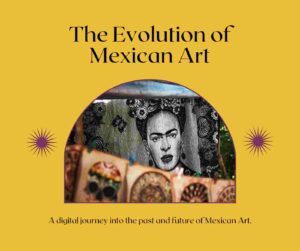
Gazing into the Future, The Evolution of Mexican Art
Peering into the future of Mexican art feels like stepping into a surreal gallery where innovation takes center stage. Imagine Gabriel Orozco as the magician, conjuring artworks that defy norms and beckon us into unexplored realms.
Orozco’s Art Revolution
Gabriel Orozco, our avant-garde maestro, doesn’t just create art, he orchestrates visual symphonies. “Yielding Stone” and “Black Kites” aren’t just installations, they’re portals to another dimension. Imagine art as a wild river and Orozco is the daring navigator, steering us into uncharted territories.
Digital Marvels in Mexican Art
Picture Mexican art embracing the digital age a canvas where pixels dance and screens come alive. Tech and art are now dance partners, creating a spectacle that transcends borders. It goes beyond mere art, it’s a captivating immersive experience. Virtual exhibitions become our global stage, inviting the world to a Mexican art fiesta with a simple click.
Brushstrokes of Sustainability and Social Echoes
The future brushstrokes aren’t just about colors, they’re about responsibility. Imagine Mexican art not just reflecting societal themes but echoing them. Sustainability isn’t a side note, it’s the canvas itself. Art becomes a mirror, reflecting the pulse of our communities, beating with the rhythm of environmental stewardship and social justice.
Why does this matter? Because Mexican art isn’t just about what we see, it’s about what we feel and the conversations it sparks. Orozco’s installations aren’t just sculptures, they’re whispers of a changing world. The digital canvas isn’t just a trend, it’s a bridge connecting us all. And when art embraces sustainability and social consciousness, it’s not just about aesthetics, it’s about impact.
Mexican Greatest Artists and Their Creations
In the vibrant tapestry of Mexican art, certain names shine as beacons, their creations weaving tales of cultural richness and artistic brilliance.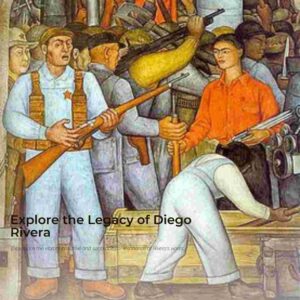
Diego Rivera: Master of Muralism
Diego Rivera, the luminary of Mexican muralism, left an indelible mark on the art world. His masterpiece murals, such as “Man at the Crossroads” and “Detroit Industry Murals,” are not mere paintings, they are sprawling narratives that chronicle the struggles and triumphs of the Mexican people. “Man at the Crossroads” at Rockefeller Center tells a story of societal crossroads, depicting the clash between industry and nature, a reflection of Rivera’s deep socio-political convictions. Meanwhile, “Detroit Industry Murals” in the Detroit Institute of Arts pays homage to the city’s labor force and technological prowess.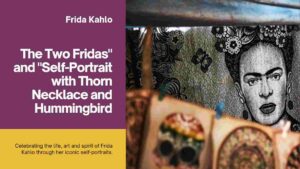
Frida Kahlo: The Symbolic Self-Portraits
Frida Kahlo, a true icon of Mexican art, expressed her pain, passion and identity through self-portraits that resonate across time. “The Two Fridas” portrays her dual heritage, reflecting the emotional turmoil surrounding her divorce from Diego Rivera. In “Self-Portrait with Thorn Necklace and Hummingbird,” Kahlo confronts her physical and emotional pain with vivid symbolism a thorn necklace and a wounded hummingbird. Through her art, Kahlo invites us into her world, where every stroke is a declaration of resilience.
Gabriel Orozco: Exploring Installations with Purpose
Gabriel Orozco, a contemporary force in Mexican art, challenges traditional boundaries with his thought-provoking installations. “Yielding Stone” exemplifies his innovative approach, featuring a massive stone with a meticulous groove created by the artist’s own hand a contemplation on the intersection of nature and human intervention. “Black Kites” introduces a kinetic element, with Orozco transforming plastic bags into soaring kites, blurring the lines between the ordinary and the extraordinary.
Sego and Saner: Street Art Visionaries
In the dynamic realm of street art, Sego and Saner stand out as visionaries capturing the essence of contemporary Mexican culture. Their creations, sprayed onto concrete canvases, tell stories of urban life, social struggles and a celebration of indigenous roots. Sego’s use of bold colors and abstract forms, combined with Saner’s intricate detailing, creates a visual symphony that resonates with the rhythms of modern Mexico.
Types of Art Mexico is Known For
When it comes to the world of art, Mexico stands out as a vibrant canvas that showcases a diverse range of artistic expressions. From ancient traditions to modern interpretations, the country boasts a rich tapestry of art forms that captivate and inspire. Let’s delve into the types of art that have become synonymous with the cultural identity of Mexico:
1. Muralism
At the heart of Mexican artistic identity lies muralism, a powerful form of public art that emerged in the early 20th century. Visionaries like Diego Rivera, David Alfaro Siqueiros and Jose Clemente Orozco used expansive murals to tell stories of history, politics and social justice. These monumental works, often adorning public buildings, are not just paintings but living narratives that engage with the community.
2. Folk Art
Mexico’s folk art is a kaleidoscope of color and craftsmanship, with each piece telling a story of cultural heritage. Alebrijes, whimsical and fantastical creatures carved from wood, showcase the mastery of Mexican artisans. Papel picado, intricately cut paper banners, add a festive touch to celebrations, while Huichol beadwork reflects the spiritual traditions of indigenous communities.
3. Textile Arts
The artistry of Mexican textiles is a testament to centuries-old weaving and embroidery techniques. Traditional garments like the rebozo and huipil are not just clothing, they are canvases that carry the stories of indigenous communities. Vibrant colors, intricate patterns and skilled craftsmanship make Mexican textiles a cherished form of wearable art.
4. Contemporary Street Art
As the urban landscape evolves, so does Mexican art. Contemporary street art has become a dynamic reflection of modern Mexican culture. From the bustling streets of Mexico City to the alleys of Oaxaca, vibrant murals and graffiti art convey the pulse of the people. Artists like Sego and Saner infuse the streets with color, addressing social issues and celebrating the spirit of the streets.
5. Papel Picado
Papel picado, translating to “perforated paper,” is a traditional Mexican folk art of cutting intricate designs into tissue paper. These delicate creations are often displayed during celebrations, adding a touch of elegance and festivity to events such as weddings, Day of the Dead and religious ceremonies.
6. Huichol Beadwork
Originating from the Huichol people, this intricate art form involves using brightly colored beads to create detailed designs on various objects, including sculptures, masks and jewelry. The beadwork often depicts spiritual motifs and symbols, reflecting the Huichol people’s deep connection to their cultural and religious beliefs.
7. Alebrijes
Alebrijes are fantastical creatures, born from the creative minds and skilled hands of Mexican artisans. Carved from copal wood, these brightly painted sculptures feature intricate patterns and vibrant colors. The art form originated in Mexico City in the 1930s, credited to artist Pedro Linares. Alebrijes often depict a fusion of animals, mythical beings and imagination, showcasing the whimsical and vibrant spirit of Mexican creativity.
8. Mexican Mosaics (Muralismo en Mosaico)
Muralismo en Mosaico, or mosaic muralism, is a captivating art form that embellishes public spaces with intricate tilework. Seen in various cities, these mosaics often portray historical events, cultural symbols and scenes of everyday life. A notable example is the work of artist Francisco Zuniga in Mexico City, whose mosaics beautifully capture the essence of Mexican life.
9. Mexican Silver Jewelry
Beyond paintings and sculptures, Mexico’s artistic flair extends to jewelry, especially silver craftsmanship. Taxco, a town renowned for its silver mines, is a hub for master silversmiths. Mexican Traditional designs, often inspired by pre-Columbian motifs, adorn silver pieces, creating jewelry that is both culturally significant and aesthetically stunning.
10. Huipil Embroidery
While we briefly touched on textile arts earlier, the significance of Huipil embroidery deserves a closer look. Huipils, traditional blouses worn by indigenous women, feature intricate embroidery that varies regionally. Each stitch tells a story, with patterns often representing the natural environment, mythology and cultural heritage. Huipil embroidery is a testament to the artistry and storytelling embedded in everyday clothing.
11. Oaxacan Wood Carvings (Xylography)
Xylography, or wood carving, has a special place in Mexican art, particularly in the vibrant creations from Oaxaca. Skilled artisans carve intricate figures, often animals and mythical creatures, from copal wood. These carvings, known as “alebrijes,” burst with color, reflecting the unique artistic traditions of the Oaxacan region.
Conclusion
In our expedition through Mexican art, we’ve unveiled a canvas painted with stories from ancient civilizations the Olmecs and the Aztecs. Diego Rivera’s murals, monumental and moving, speak of struggles, triumphs and the resilient spirit that defines Mexico.
Preserving this artistic legacy isn’t just a duty, it’s a celebration of our roots and an investment in our collective future. Mexican art, alive and evolving, is a testament to the stories etched by those who came before us and the groundwork laid for generations to come.
To truly embrace Mexican art’s beauty, engage firsthand. Explore local galleries, where each brushstroke tells a story and online exhibits that bridge tradition and innovation. Immerse yourself in the kaleidoscope of colors, the rhythmic dance of symbolism and the ever-evolving narrative that is Mexican art.
In every stroke, every sculpture and every piece, you’ll find a connection to a culture thriving on creativity. Let the canvas of Mexican art be not just a visual delight but a journey into the heart and soul of a nation, beckoning you to explore, appreciate and become part of this enduring legacy.
So, as you stand before Mexican art, remember, it’s not just an expression of the past, it’s an inspiration for your future. Let the brushstrokes guide you on a path of discovery, where art is not just seen but felt a journey through time, a dance of colors and a celebration of the stories that make us who we are.
- Mar 20, 2024
Native Mexican Animals: Fascinating Wildlife
Fascinating Wildlife of Mexico: Native Mexican AnimalsWelcome to the top notch international of Mexico's natural world! Mexico is a place
- Mar 14, 2024
Safeway Money Order: Best Locations
Find out how easy and safe it's miles to ship cash with Safeway Money Orders. This manual suggests where to
- Mar 08, 2024
The Stock Market Plumbing To
In the complicated world of investing, the stock market plumbing sounds like a strange term. But it is an apt
- Feb 24, 2024
Beyond Finance Legit: Navigating with
Beyond Finance Legit: Unraveling the Legitimacy of Financial Service Providers in Today's Complex Landscape In modern-day complicated monetary panorama, it
- Feb 21, 2024
The Fundamentals of Corporate Finance
Unveiling the Core Tenets: Exploring 'The Fundamentals of Corporate Finance' When we talk about the fundamentals of corporate finance, we're



